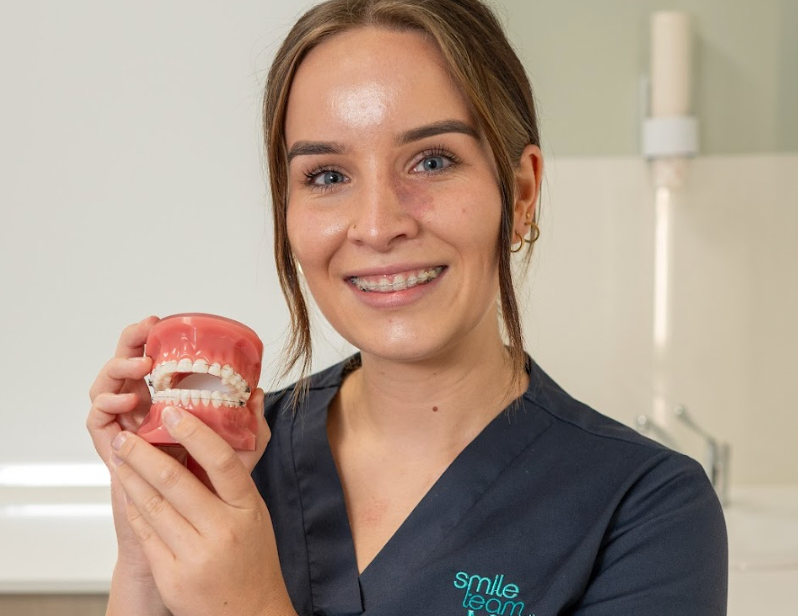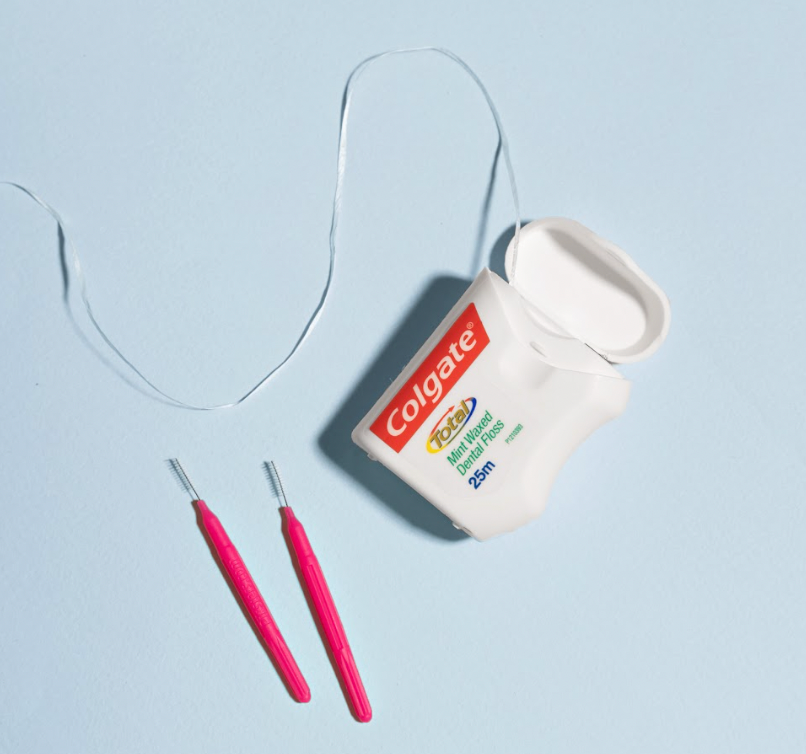
Proper oral hygiene with braces prevents tooth decay and gum disease. Wearing braces increases the risk of food and bacteria becoming trapped around the teeth, leading to plaque formation and bacterial colonies.
Flossing is an essential part of oral hygiene that helps to remove food debris and bacteria from hard-to-reach areas, especially with braces. However, it can be tricky. We have compiled this guide to help you understand the proper technique and best practices to floss with braces.
Why Flossing with Braces Matters
Floss with braces to remove food particles and plaque from hard-to-reach places easily missed by brushing alone, especially with brackets and wires in the way. Braces can trap food, plaque, and bacteria, which leads to gum diseases and tooth decay.
Failure to floss properly can lead to cavities, as food particles trapped around the orthodontic wires and brackets can quickly attract bacteria, producing acids that cause tooth decay and cavities.
Types of Dental Floss for Braces
Several types of dental floss are specifically designed for braces, including traditional floss, floss threaders, and orthodontic floss picks.
Traditional Dental Floss

Traditional floss is a string of nylon available in two main types: unwaxed and waxed. Waxed floss has a thin wax overlay that prevents the floss from shredding or accidentally snagging on the braces, providing more thorough cleaning.
Traditional flossing effectively removes food particles and bacteria between teeth and under the gum line, providing a thorough cleaning. It is a cost-effective option, readily available at pharmacies and grocery stores.
However, traditional unwaxed floss can be difficult because it can start to shred and get caught on the brackets. Also, it can be time-consuming and require a certain amount of dexterity, especially for young children or teens.
Floss Threaders
Floss threaders are thin, flexible pieces of plastic designed to guide dental floss between dental work, such as braces, bridges, and permanent retainers. They are reusable and inexpensive, and they work with any regular floss.
The convenience and effectiveness of floss threaders are highlighted by their ability to make flossing with braces more manageable and thorough. They assist in flossing with braces by allowing the floss to be easily manoeuvred beneath the archwire, enabling cleaning in hard-to-reach places.
Orthodontic Floss Picks
Orthodontic floss picks are an excellent option for flossing with braces, especially for those who find traditional dental floss challenging. They consist of a plastic handle with a short piece of floss attached and designed for cleaning around orthodontic brackets and wires.
Floss picks make flossing with braces more user-friendly and easier to hold and manoeuvre. Their angled design and small size help them reach tight spaces more effectively.
How to Floss with Braces
Flossing with braces may seem daunting initially, but it is important for maintaining good oral health during orthodontic treatment. Follow these six simple steps of the flossing process to effectively floss your teeth with braces:
Step 1: Preparation
Before you start flossing, gather all your supplies. Make sure you have floss of your choice, a mirror, and a floss threader or orthodontic floss picks if needed. Choosing the right type of dental floss that effectively cleans around braces and wires without getting caught is essential.
Step 2: Thread the Floss
If you use traditional dental floss, use a floss threader to guide the floss between the wires and braces. Insert one end of the floss through the loop in the threader, then pull it through.
Step 3: Flossing Technique
Hold the floss with thumbs and index fingers, leaving an inch or two of floss in between. Gently guide the floss under the archwire of the braces by using the floss threader or orthodontic floss picks.
Once the floss is beneath the archwire, slide it up and down between each tooth. Be sure to thoroughly clean both sides of every tooth, including around brackets and wires.
Step 4: Cleaning Between Teeth
Make sure to clean between every tooth, including the back molars. Pay extra attention to brackets and wires where food particles are more likely to be trapped.
Step 5: Flossing with Wire Behind Teeth
Use the same technique as before for teeth with a wire behind them but be sure to angle the floss upward and downward to ensure comprehensive cleaning.
Step 6: Rinse and Repeat
Once you have finished flossing your teeth with braces, rinse your mouth thoroughly with water or an antibacterial mouthwash. Repeat this process at least once a day, preferably before bedtime.
Tips and Tricks for Effective Flossing
Navigating around wires and brackets can make flossing with braces a challenging task. But there are tips and tricks to do it more easily and effectively.
Proper Tools
Investing in the right tools can make flossing with braces significantly easier. A floss threader or orthodontic flosser is designed for braces and can help navigate the wires effectively. Disposable floss picks can also be handy, especially if you’re on the go. Try out different options to see what works best for you.
Regular Flossing Routine

Consistency in your oral care routine is key to maintaining oral health with braces. Floss regularly, ideally after each meal, to remove food particles trapped in your braces. Not only will this help keep healthy teeth and gums, but it will also make your braces more effective.
Professional Guidance
While these tips can help, consulting with a professional for personalised advice is essential. Your orthodontist or dentist can provide specific guidance based on your needs and ensure that your flossing technique is effective. At Smile Team, our professionals are always available to provide you with the best advice and ensure your smile is at its best.
Flossing with Braces FAQs

Is it OK to water floss with braces?
It is OK to use a water flosser with braces. A water flosser, or oral irrigator, can effectively clean around braces and remove food particles and plaque. It uses pulsating water to clean between teeth and around the gum line, which can benefit individuals with orthodontic treatment.
Is it OK to floss every other day with braces?
It is not recommended to floss only every other day with braces. Floss daily to prevent plaque build up and tooth decay. Braces can make it hard to clean certain areas of the teeth, but regular flossing helps maintain oral hygiene and prevent dental issues.
Can an orthodontist tell if you don’t floss?
Orthodontists can often tell if you don’t floss, especially when you have braces. Failing to floss can lead to plaque build-up, which may be visible during orthodontic appointments.
Do gums get stronger when you floss?
Flossing can contribute to healthier gums but does not necessarily make them stronger. Proper flossing removes plaque and food particles, which avoids oral health problems. However, the strength of gums is influenced by various factors, including overall oral hygiene, genetics, and individual health conditions.
Do you floss or brush first?
It is recommended to floss before brushing. Flossing before brushing removes sticky sugars and bits of food between teeth and around braces, as well as plaque build-up between teeth.
What happens if you never floss?
If you never floss, you may experience an increased risk of plaque buildup, tooth decay, and gum disease. Flossing removes food particles and plaque, improving oral hygiene and reducing the likelihood of dental issues.
Conclusion
Flossing with braces is possible if you know how to tackle it correctly. It’s ideal to use special tools like floss threaders and super floss and products specifically designed for those with braces.
After all, one must take proper care of oral health while having braces to enjoy a beautiful and healthy smile when all is said and done! Considering the above tips will make for an optimal orthodontic experience, so pay them special attention.
Now, get out there and have a beautiful smile!
